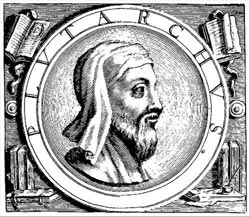
Sun-Earth Day Presents: Eclipse, In a Different Light
Though the earliest descriptions of eclipses are few in number, they never fail to mention the splendor of the corona.
TECHNOLOGY THROUGH TIME ISSUE #36: FIRST CORONA DESCRIPTION

Depiction of Plutarch.
It's amazing to think that in the thousands of years that humans have admired total solar eclipses, virtually no ancient sketches or descriptions of the details of such an event have survived. These eclipses were regarded with great interest by dozens of civilizations spanning 3000 BC to 1000 AD. Among the most famous were the Ancient Egyptians. One would imagine that a total solar eclipse of their chief god Ra would have been cause for comment on at least one monument. (See NASA-Eclipse 99 "Solar Eclipses in Ancient Egypt")
The most often quoted account of an eclipse (possibly on March 20, 71 AD) is that provided by the Greek philosopher Plutarch (45-120 AD), found in sections 931D-E of his book, De Facie in Orbe Lunae (On the face which appears in the Moon). Although the description is not believed to be written in Plutarch's own voice, but is an account narrated by a character named Lucius, it notes that,
"Now, grant me that nothing that happens to the sun is so like its setting as a solar eclipse. You will, if you call to mind this conjunction recently which, beginning just after noonday, made many stars shine out from many parts of the sky and tempered the air in the manner of twilight."
A more intriguing comment follows in a later section (932B) in which Lucien notes that,
"Even if the moon, however, does sometimes cover the sun entirely, the eclipse does not have duration or extension; but a kind of light is visible about the rim which keeps the shadow from being profound and absolute."

If you sit at a normal reading distance of 20 inches from the computer screen, this image of a total solar eclipse is about the size it would appear to you in the sky. Can you see the corona well enough to sketch it?
A more recent description of the solar corona was written in 968 AD by the Byzantine historian Leo Diaconus (ca. 950-994 AD) at an age of about 18 years. He observed the total eclipse of 22 December 968 from Constantinople (now Istanbul, Turkey). His observation is preserved in the Annales Sangallenses, and reads:
"...at the fourth hour of the day ... darkness covered the earth and all the brightest stars shone forth. And is was possible to see the disk of the Sun, dull and unlit, and a dim and feeble glow like a narrow band shining in a circle around the edge of the disk".
Leo the Deacon (Leo Diaconus) was born around the year 950 AD. In his early youth he came to study at Constantinople and was ordained deacon by the Catholic Church. In 986 he took part in the war against the Bulgars under the Emperor Basil II (976-1025), was present at the siege of Triaditza (Sofia), where the imperial army was defeated. He barely escaped with his life. After the year 992 he began to write a history of the empire, presumably at Constantinople. The work is incomplete. Apparently he died before he could finish it.
The Annales Sangallenses maiores are annals compiled in St. Gallen, covering the years 927 through to 1059. They continue the Annales Alamannici, the St. Gallen version of which reaches up to 926.
A much older possible description of the corona is said to be found on engraved oracle bones dating from the Shang dynasty in China (1766 to 1123 BC), but is far more ambiguous and open to interpretation than either the Plutarch or Diaconus' descriptions.
Technology Through Time
ISSUES
- #46: The Magnetic Sun
- #45: Coronagraph
- #44: Einstein
- #43: Coronium
- #42: The Sun - In a Different Light
- #41: Gallery of Drawings
- #40: First Sun Photo
- #39: Solar Spectroscopy
- #38: George Ellery Hale
- #37: Coronal Mass Ejections
- #36: First Corona Descriptions
- #35: First Sunspot Drawing
- #34: Ptolemy
- #33: Ancient Greece
- #32: Ancient Babylon
- #31: Galileo Galilei
Eclipse Fact
A total solar eclipse is not noticable until the Sun is more than 90 percent covered by the Moon. At 99 percent coverage, daytime lighting resembles local twilight.





